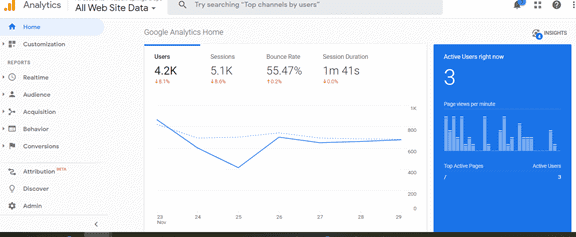As a website owner, you may wonder what a “bounce rate” is and why you should care about it. We’ll tell you what it is, but first, the “why.”
In short, the bounce rate is a key metric that indirectly measures the value of your site content to visitors. It measures what happens based on their first impression and probably foretells the site’s success. Why is that important? In short, a lousy website experience for your customers generally equals lousy business for you.
What is Bounce Rate?
What exactly is the bounce rate, and what does an acceptable rate look like?

Bounce rate is the percentage of users visiting your site, looking around, and leaving without doing anything. No scrolling, clicking, or conversions – simply bouncing in and out of your website without taking any other action. In short, it is where the visitor leaves the exact page they entered without ever viewing any other pages.
This is different from Exit Rate. Exit rates are the percentage of exits from a page, regardless of whether the user viewed other pages.
In Google Analytics, you can get an overview of your website’s bounce rate and need to dig deeper for detailed statistics. Here, search intent may be an essential determinant of why visitors bounce. If a page on your site isn’t fulfilling why the visitors land on your site, they bounce.
Sometimes, despite catering to that initial search intent, the bounce rate remains high. Why? Because while you may be satisfying the visitor’s search intent, the site isn’t providing sufficient value to engage the visitor further.
To know which pages have a high bounce rate, check out the User Flow option in your Google Analytics account.
What Is The Average Website Bounce Rate?
For instance, retail sites have a 20-40% bounce rate. Portals are 10-30%, and lead generation sites are 30-50%. However, content sites often have around a 40-60% bounce rate.
 Typically, anything between 56-70% can be considered high. The bounce rate is calculated by the total number of single-page visits divided by the total number of site visits.
Typically, anything between 56-70% can be considered high. The bounce rate is calculated by the total number of single-page visits divided by the total number of site visits.
However, 41-55% is the average bounce rate, and the 26-40% range is excellent.
Essentially, a good bounce rate is whatever keeps your business going and profitable. On the other hand, an alarming bounce rate means no-to-low conversions, and the site is not meeting visitors’ expectations.
What Affects this Metric?
The website’s overall design, usability, Search Engine Optimization, and functionality are important factors that affect the bounce rate. Here are a few more things that impact the bounce rate:
- Slow page loading
- Misleading/sloppy content
- Blank pages
- Single-page sites
- Heavily affiliated landing page
- Under-optimized/poor content
- Unsatisfactory user experience
- Asking for too much info
How to Improve the Bounce Rate?
There is no quick fix or one-size-fits-all solution to improving the bounce rate. Fortunately, there are some tried and true methods to help you. These tips will ensure your website is more user-friendly, quick to load, improves engagement, and invites a lower bounce rate:
No Click Bait: Refrain from using click baits or deceptive descriptions. Not providing visitors with engaging, relevant, and valuable information will disappoint them and bounce them off the page.
Faster Page Speed: This one goes without saying – pages that load in more than 3 seconds are a surefire way to bounce your visitors. Say no to bulky media files, too many plugins, or heavy coding. Take steps to optimize the website and improve its loading speed.
Noticeable CTAs: Have a clear, concise, and correctly placed (single and not multiple) Call-To-Action on every page of your website. Your visitors must know precisely what to do or where to navigate.
Responsive Design: Use a responsive layout for your website to make mobile browsing seamless.
Helpful 404 Page: It is a good practice to have a 404 error page to inform visitors that the link is broken. But it works wonders if you can offer some bonus content and an apology note to keep visitors interested.
Interlinking: Crosslink different relevant pages on your website throughout the content. It gives visitors easy access to something new, extra, and interesting, decreasing the bounce rate.
Search Bar: This one’s often neglected, but you can consider adding a search bar in the header or footer. It will allow visitors to discover answers to their questions in depth.
Live Chat: It is another technique that may improve visitor engagement.
Offer Value: Ensure your content provides visitors with relevant, even educational value. Each page should address questions your audience might have.
Maintain Formatting Consistency: When writing for the web:
- Keep uniformity with your content
- Use appealing headings and subheadings
- Use short, concise paragraphs
- Vary the lengths of sentences
- Keep experimenting to see what works and what does not.
Eye-Pleasing Color Scheme: Color theory is critical to having a responsive, fast, and secure website. So, create a visual website design that suits your particular business category. Modern sites use plenty of white space, black text primarily, and sophisticated themes to make viewing more enjoyable.
Improve Navigation: Display the “Menu” option prominently. Link to important pages, and maybe even place your search bar there. It makes website navigation straightforward.
Informative Landing Pages: Get into the details to interest your visitors and remain organized and relevant. Create your landing pages as informative as possible and guide visitors from start to end.
Popup with Care: Since popups are standard, visitors avoid them or the website altogether. Popups encourage sign-up, but not everyone’s on your website to join the mailing list. The bottom line is to use popups with discretion and monitor how they impact your site’s bounce rate.



